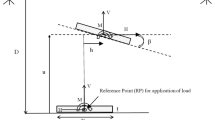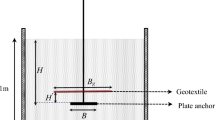Abstract
Anchors embedded in soil are used to restrain horizontal movement of structures, especially pipelines. Block anchors are not thoroughly studied in the literature as compared to plate anchors. This research paper intended to address this gap and contribute to the field by studying various parameters influencing the behavior of block anchors embedded in sand when subjected to a horizontal load. The behavior focuses on the pullout capacity and displacements/rotation of the block anchor, and the failure mode of the soil. The parameters studied include width, depth, and thickness of the block; depth of embedment below the ground surface; location of the pulling load; and the degree of saturation of the soil. The rigorous research methodology consists of numerical, analytical, and experimental approaches. First, the analytical calculations were based on Rankine, Coulomb, and log spiral theories to obtain values for the pullout capacity, for the 3-D magnification factor, and for the mobilized friction angle. Second, the experimental work included pullout tests, made in the laboratory, on concrete block anchors of various dimensions and on steel plate anchors, embedded in sand at two different depths. The sand was deposited in a box by pluviation to ensure a uniform and reproducible density. Materials properties were determined, and instruments were calibrated. The load and the corresponding horizontal and vertical displacements were recorded, and visual observations of the failed soil surface were captured. Finally, the numerical computations used PLAXIS program for the 2-D cases to obtain the pullout capacity and the deformation for long anchors. The main findings of this study show that the block anchor has a higher pullout capacity than a plate anchor; and the depth of embedment and the moisture condition of the sand significantly affect the pullout capacity, while the thickness of the block and the exact location of the load do not significantly affect the capacity. The capacity of a short block anchor per unit width decreases with increasing width, as the 3-D effect reduces. With reference to dry sand, the capacity of the anchor is doubled if the sand is unsaturated/wet, but it is reduced to only one half if the sand is saturated. The experimental results were compared with the analytical calculations and also with the numerical computations. The analytical results were also utilized for the experimental design. The results of numerical computations were used to validate the experimental design and to explain experimental findings, especially failure mode and deformation. The findings of this research are also compared with other studies reported in the literature. These findings have very significant implications to the analysis and design of the block anchor. They also contribute to the hazard risk assessment of block anchors embedded in sand subjected to variations in the environmental condition of wetting and drying cycles.




















Similar content being viewed by others
References
Bowles, J. E. (1997). Foundation Analysis and Design (5th ed.). New York: McGraw-Hill. 1175 p.
Hueckel, S.: Model tests on anchoring capacity of vertical and inclined plates. In: Proceedings of Fourth International Conference on Soil Mechanics and Foundation Engineering, London, vol 2, 203–206 (1957)
Hueckel, S., et al.: Distribution of passive earth pressure on the surface of a square vertical plate embedded in soil. In: Proceedings of Sixth International Conference on Soil Mechanics and Foundation Engineering, Montreal, vol 2, pp 381–385 (1965)
Ovesen, N.K.; Stromann, H.: Design methods for vertical anchor slabs in sand. In: Proceedings, Specialty Conference on Performance of Earth and earth-Supported Structures. ASCE, vol. 2.1, pp.1481–1500 (1972).
Neeley, W.J.; Stuart, J.G.; Graham, J.: Failure loads of vertical anchor plates in sands. J. Soil Mech. Foundations Divis. Proc. ASCE 99(9), 669–685 (1973)
Das, B.M.: Pullout resistance of vertical anchors. J. Geotechn. Eng. Divis. ASCE 101(GT1), 87–91 (1975)
Das, B.M.; Seeley, G.R.: Load-displacement relationship for vertical anchor plates. Civil Eng. Pract. Des. Eng. 4, 191–209 (1975a).
Das, B.M.; Seeley, G.R.: Passive resistance of inclined anchors in sand. J. Geotechn. Eng. Divis. ASCE. 101 (no.GT3), 353–356 (1975b).
Das, B.M., et al.: Ultimate resistance of deep vertical anchor in sand. Soil Foundations Japanese Eng. Soc. 17 (no. 2), 53–56 (1977).
Akinmusuru, J.O.: Horizontally loaded vertical plate anchors in sand. J. Geotechn. Eng. Divis. ASCE 104(GT2), 283–286 (1978)
Dickin, E.A.; Leung, C.F.: Centrifugal model tests on vertical anchor plates. J. Geotechn. Eng. Divis. ASCE 109(12), 1503–1525 (1983)
Dickin, E.A.; Leung, C.F.: Evaluation of design methods for vertical anchor plates. J. Geotechn. Eng. ASCE. 111 (no. 4), 500–520 (1985).
Das, B.M.; Moreno, R.: Model tests for pullout resistance of vertical anchors in clay. J. Geotechn. Eng. ASCE. 101 (no.GT7), 711–715 (1985).
Ghaly, A.M.: Load-displacement prediction for horizontally loaded vertical plates. J. Geotechn. Geoenviron. Eng. ASCE 123(1), 74–76 (1997)
Merifield, R.S.; Sloan, S.W.: The ultimate pullout capacity of anchors in frictional soils. Can. Geotech. J. 43, 852–868 (2006)
Merifield, R. S.; Lyamin, A. V.; Sloan, S. W.: Three-dimensional lower-bound solutions for the stability of plate anchors in sand. Geotechnique. 56(2), 123–132 (2006)
White, D. J.; Cheuk, C. Y.; Bolton, M. D.: The uplift resistance of pipes and plate anchors buried in sand. Getechnique. 58(10), 771–779 (2008).
Frydman, S.; Shaham, I.: Pullout capacity of slab anchors in sand. Can. Geotech. J. 43, 852–868 (1989)
Duncan, M.; Mokwa, R.: Passive earth pressures: theories and test. J. Geotechn. Geoenviron. Eng. ASCE. 127(4), 248–257 (2001)
Akash, S.; Marwan, A.; Ramesh, V.; Karim K.: Numerical and analytical studies of 3D effects on pullout capacity of anchor blocks in granular compacted fill. Int. J. Geosyn. Ground Eng. 7(1), Article number 13 (2021).
Maming, M.I.; Djamaluddin, A.R.; Harianto, T.; Muhiddin, A.B.: Model test of the pull-up capacity of folding type ground anchors in cohesive soil. Civil Eng. J. 8(09), 1846–1856 (2022)
Al‐Shayea, N. A.: Pullout capacity of block anchor in unsaturated sand. In: Proceedings of the ASCE 4th International Conference on Unsaturated Soils, Geotechnical Special Publication, Issue 147, pp 403–414 (2006).
Teng, W. C.: Foundation design. Prentice-Hall Inc., New Jersey, 466 p (1662).
Singh, A.I.: Soil Engineering in Theory and Practice. Asia Publishing House Inc, New York (1967)
Ovesen, N.K.: Passive Anchor Slabs, Calculation Methods and Model Tests. Danish Geotechnical Institute. Bull. 4, 5–39 (1964)
Hansen, J.B.: Resistance of rectangular anchor slab. Danish Geotechnical Institute, Copenhagen 21, 12–13 (1966)
Al-Shayea, N.A.; Abduljauwad, S.; Bashir, R.; Al-Ghamedy, H.; Asi, I.: Determination of parameters for a hyperbolic model of soils. In: Proceedings of The Institution of Civil Engineers, Geotechnical Engineering, Vol. 156 (2), pp. 105–117 (2003)
Janbu, N.: Soil compressibility as determined by oedometer and triaxial tests. In: Proceedings of European Conference on SMFE, Wiesbaden 1, 19–25 (1963)
Schanz, T.; Vermeer, P.A.: Angles of friction and dilatancy of sand. Geotechnique 46, 145–151 (1996)
Abduljauwad, S.N.; Al-Ghamedy, H.N.; Siddiqui, J.A.; Asi, I.M.; Al-Shayea, N.A.: Stability of vertically bent pipelines buried in sand. J. Pressure Vessel Technol. Trans. ASME. 126(3), 382–390 (2004)
Al-Ghamedy, H.N.; Abduljauwad, S.N.; Siddiqui, J.A.; Al-Shayea, N.A.; Asi, I.M.: Cover requirement and stability of horizontally bent buried pipelines. J. Pressure Vessel Technol. Trans. ASME. 134(2), 021701 (2012)
Al-Shayea, N.A.: Inherent heterogeneity of sediments in Dhahran, Saudi Arabia-a case study. Eng. Geol. 56(3–4), 305–323 (2000)
Acknowledgements
The authors acknowledge the support of King Fahd University of Petroleum & Minerals.
Author information
Authors and Affiliations
Corresponding author
Rights and permissions
Springer Nature or its licensor (e.g. a society or other partner) holds exclusive rights to this article under a publishing agreement with the author(s) or other rightsholder(s); author self-archiving of the accepted manuscript version of this article is solely governed by the terms of such publishing agreement and applicable law.
About this article
Cite this article
Al-Shayea, N., Hasan, A. Parametric Study for the Behavior of Blocks Anchor Embedded in Sand at Various Conditions. Arab J Sci Eng (2024). https://doi.org/10.1007/s13369-024-09048-9
Received:
Accepted:
Published:
DOI: https://doi.org/10.1007/s13369-024-09048-9




